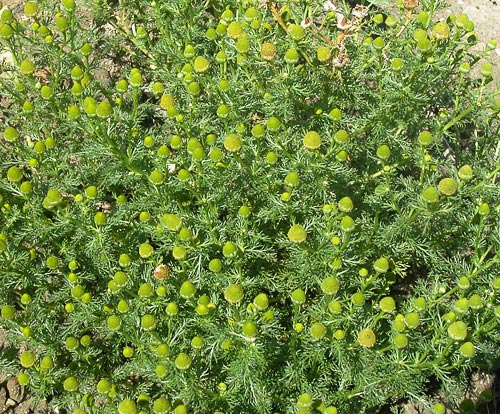Weeds
Lepidotheca suaveolens (Pursh) Nutt. - Rayless Mayweed, Pineapple Weed.
Systematic position.
Family Asteraceae, genus Lepidotheca Nutt.Synonyms.
Santolina suaveolens Pursh, Artemisia matricarioides Less., Chamomilla discoidea (DC.) J.Gay ex A.Br., C. suaveolens (Pursh) Rydb., Matricaria discoidea DC., M. matricarioides (Less.) Porter, M. suaveolens (Pursh) Buchenau, Chrysanthemum suaveolens Aschers, Cotula matricarioides Bong., Tanacetum suaveolens Hook.Biological group.
Annual spring weed, able to develop as winter and biennial weed.Morphology and biology.
Root thickened, with numerous thin branches. One or several stalks being straight, 5-30 cm in height, ramified in upper half mainly, fistular, naked or pubescent under anthodium only. Leaves oblong; 30-60 mm in length, 5-20 mm in width; twice pinnatisect; with linear, short, pointed segments; broadened at base and somewhat amplexicaul; naked. Inflorescences corymbose, located at apices of stalks and branches. Floriferous peduncle 5-15 mm in length, thickened under anthodium. Anthodia solitary, numerous, 7-15 mm in diameter, with ovoid-conic naked receptacle. Involucre triple; its leaflets elliptic, blunt, with wide, white, brilliant, membranous margin. All flowers tubular, chartreuse, with quadrident corolla. Hemicarps oblong, 1.25-2 mm in length, 0.5 mm in width, slightly bent, smooth on back surface, brown, with three indistinct costulae on inner side and with two lateral resinous stripes. Pappus is absent, or it is present as hardly discernible serrated margin. Blossoming in July - October, fruiting in August - October. One plant produces to 5300 hemicarps. Weight of 1000 seeds is 0.15 g. Shoots appear in spring and summer-autumnal period (the summer-autumnal shoots winter in southern areas). The minimal temperature for germination of seeds is 2-4°C, optimum is 22-24°C.Distribution.
Scandinavia, Europe, East Mediterranean, Northern and Southern (Chile) America, New Zealand. Arctic regions (Chukotka), the Caucasus, Western and Eastern Siberia, the Far East, Central Asia (Balqash).Ecology.
The species likes open places; it is especially abundant in damp habitats (forest zone); it prefers loamy and sandy-loamy soils having enough nutrients. It is a ruderal weed plant forming quite often thickets in population places, in streets, yards, along roads, on pastures, along margins of fields.Economic significance.
Meets on fields of winter and summer grain crops, tilled cultures, perennial grasses, in kitchen gardens and orchards. Control measures include careful autumn treatment of ground including stubbling and plowing, spring preplant cultivation, interrow treatments of tilled cultures, cleaning of ground from seeds of the weed on fallows by layer treatment of ground; application of herbicides, if necessary.Related references:
Anon. 1996.Weeds on sugar beet.Berlin: Hoehst Shering AgrEvo Gmbh. 374 p. (In Russian) Nikitin, V.V. 1983. Weeds in the flora of the USSR. Leningrad: Nauka. 454 p. (In Russian)Shishkin, B.K. & Bobrov E.G., eds. 1961. Flora of the USSR. V.26. Moscow & Leningrad: AN SSSR. 940 p. (In Russian)
Ulyanova, T.N. 1998. Weeds in the flora of Russia and other CIS states. St.Petersburg: VIR. 344 p. (In Russian)


